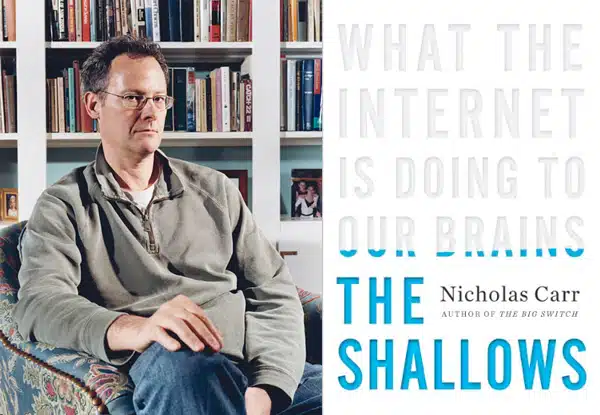When it comes to brain development, technology gets a bad rap. Nicholas Carr, author of The Shallows: What the Internet is Doing to Our Brains, compares our new ways of interacting to a backwards evolution:
“We are evolving from cultivators of personal knowledge into hunters and gatherers in the electronic data forest. In the process, we seem fated to sacrifice much of what makes our minds so interesting.”
Last week’s blog tailed off with a different comparison. We suggested the connection between heads-up technology, which forms genuine social connections, and how those technologies reflect early childhood experiences. This week delves more into the question of how technology impacts brain development, especially when parsed by what we like to call heads-up and heads-down varieties. This is pertinent among children who are now spending their formative years engaged with technology. Technology observably impacts our social habits, but more easily overlooked is how it physically rewires our brain.

Photo: Antenna
How is technology “rewiring” our brains?
The speed at which technology is changing and entering our world means that research on how it psychologically influences us can’t possibly keep up. But one thing is likely—technology is rewiring our (and especially our children’s) brains in ways that we haven’t yet encountered and don’t fully understand.
A 2007 UCLA study measured brain activity of experienced vs. non-experienced web-users in their prefrontal cortexes, areas associated with problem-solving and decision-making. The study found localized brain activity in experienced users much higher than their counterparts, even though brain activity was comparable across all participants when exposed to non-internet-based reading tasks. After instructing the non-users to engage in internet use for one hour per day for six days, the study was repeated and found comparable brain activity across all users.
That isn’t to say that internet exposure, or technology in general, is necessarily rewiring our brains in bad ways, just different ways.
Even though this is only a single study in a large body of research on technology and brain activity, it just goes to show the incredible plasticity of our brains and how quickly technology exposure has a physical and yet subconscious influence on our social and sensory experiences. It’s also worth noting whether studies of this type differentiate what we’d consider heads-up or heads-down technology; this particular study on internet use would definitely fall under the latter type.

Photo: The News International
That isn’t to say that internet exposure, or technology in general, is necessarily rewiring our brains in bad ways, just different ways. Using technologies like the internet has a tendency to frequently redirect our attention, forcing our brain to spend energy reorienting itself at the expense of comprehension. These sacrifices are known to researchers as switching costs. Considering the overload of advertising, hyperlinks, and other visual re-directors, it’s no surprise that humans are cognitively paying a higher price for switching costs than ever before.
The pros and cons of heads-down technology on brain development
If the influence of technology burdens us with switching costs, what are the benefits of technology, especially of the heads-down variety, in rewiring our brains? Nicholas Carr, a fan of Neolithic metaphors, describes the cognitive skills brought on by internet consumption as “primitive mental functions:”
- Hand-eye coordination
- Reflex response
- Visual-cue processing
- Fast-paced problem solving
- Credibility assessment
- Pattern detection
While these influences have their benefits, they are seemingly more base than socially interactive in their enhancement of human brain function. Evidently, a balance of the two is ideal for healthy brain development, especially in children. Patricia Greenfield, a developmental psychologist at UCLA reviewed over 40 studies in 2009 to assess the effects of technology and media on intelligence and learning. According to Greenfield, the “widespread and sophisticated development of visual-spatial skills” has come at the expense of “deep processing,” “mindful knowledge acquisition, inductive analysis, critical thinking, imagination, and reflection”—skills that, one could argue, are more relevant to forming our social tendencies early on in life.
Balancing technology and brain development
We’ve already discussed how heads-up technology is designed to encourage face-to-face interaction in social settings. It engages users with their surrounding environment rather than isolating their attention spans. In terms of technology rewiring our brains, there are parallels between heads-down technology and the visual-spatial skills it enhances, and heads-up technology and the “deep processing” skills Greenfield speaks of.
Multisensory tech encourages our brains to fire on all cylinders rather than tune out certain aspects of brain development, and could be good for encouraging critical thinking and focusing attention in young brains that respond well to non-conventional learning styles.
In an ideal world, humans would have the self-awareness and control to use both technology types in healthy amounts and encourage the same use among their children. “Heads-up technology” is only a novel idea because it is usually the exception rather than the norm, however. Heads-down tech just seems to be more widely accessible and leaves us more susceptible to unhealthy, addictive tendencies. If we hope to avoid the detrimental effects this has on our (and our kids’) brain development, there needs to be more research on what separates heads-up from heads-down technology and how the use of each is “good” for brain development.

Photo: Super Glam Moms
Multisensory technology and brain development
One area of research that studies the influence of what we’d consider heads-up technology on brain development focuses on children with Autism Spectrum Disorder and multisensory experiences. One such study, conducted at the Albert Einstein College of Medicine at Yeshiva University, found that children diagnosed with ASD do not process multisensory information as effectively or quickly as other children in that age group. This kind of research points to why there is a burgeoning industry of multisensory experiences and therapies geared toward families living with autism. The Children’s Museum of Atlanta, for example, hosts a regular multisensory program. One of the Yeshiva study authors went as far as to compare multisensory integration therapies to a “military-industrial complex.”
While there is definitely more room for research on the direct impacts of multisensory and heads-up technology on our brains, perhaps the approach’s popularity has more to do with the impacts of heads-up technology regardless of a diagnosis like ASD. Multisensory tech encourages our brains to fire on all cylinders rather than tune out certain aspects of brain development, and could be good for encouraging critical thinking and focusing attention in young brains that respond well to non-conventional learning styles. Continued research in this area will help us decide how to balance our exposure to various kinds of technology and approach product design, especially for children.
This week’s article evolved into what feels more like a research paper than your average blog, closing with more questions than solutions and answers. We know relatively little about the long-term effects that technology consumption has on the human brain, and we know even less about those effects when you try separating technology into categories like heads-up and heads-down. At the end of the day, a healthy dose of both types is likely ideal for well-rounded brain development, and we’re seeing a growing emphasis on engaging, multisensory technologies to influence that development, especially among children and those with disorders like autism.
One way of delving further into this topic is by looking more specifically into the science behind multisensory experiences. Public spaces are investing more into services and displays that captivate and engage audiences on auditory, visual, tactile, and even olfactory levels. Tune in next week to find out more about what’s behind the growing appeal for multisensory technologies.
